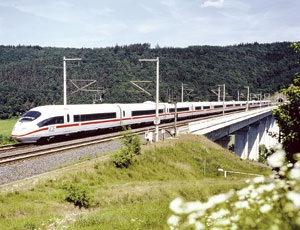States may begin chasing lucrative High-Speed Intercity Passenger Rail grants as early as July 10 by submitting “pre-applications” for up to $8 billion of economic stimulus funds.
The Federal Railroad Administration released guidelines on June 17. “It will be illuminating to see which projects are ready to progress, on what time frame and at what cost,” says Donald M. Itzkoff, partner, Nossaman LLP, Washington, D.C. Detailed applications are due by Aug. 24 for grant categories called “Tracks” 1, 3 and 4 and Oct. 2 for “Track” 2. “These documents will be hundreds of pages long,” says Richard J. Peltz, senior consultant at Gannett Fleming Inc., Harrisburg, Pa. “I’m not sure if states understand it will cost tens of thousands of dollars just to prepare the proposals.”

The $8 billion is allocated to Tracks 1 and 2, with another $90 million for Tracks 3 and 4. Track 1 is for ready-to-go two-year intercity passenger-rail projects. Track 2 is high-speed/intercity corridor services with phased implementation. Track 3 is for development of cooperative agreements that require a 50% non-federal match, and Track 4 is five-year intercity rail projects with a minimum 50% non-federal match.
Grants cover final design and construction under Track 1 and milestone accomplishments via letters of intent in Track 2. Funds apply to high-speed trains operating at 110-150 mph over 100-600 miles and intercity rail trains operating at 79-110 mph over 100-plus miles.
Rail projects will be evaluated in three main categories: public return on investment; project success factors, such as management, engineering and financial strength; and schedule. Region, innovation, environmental impact, proposed operator and rail safety through positive train control also may be considered. Grants will be awarded by late September for work to start by September 2012.
Selected states must establish written agreements with applicable railroads on right-of-way use and ownership. Grant recipients must buy American steel, iron and manufactured goods, although FRA may waive this provision. One spin-off could be the return of U.S. manufacturing jobs.
In California, the High- Speed Rail Authority (CHSRA) is working on an 800-mile high-speed route from San Diego to Sacramento. At speeds up to 220 mph, travel time from Los Angeles to San Francisco will be shaved to 2.5 hours. The $33-billion Anaheim-San Francisco segment will be completed by 2020 and could generate annual revenue of $2.4 billion. Public-private partnerships will contribute $6.5 billion to $7.5 billion, local funds $2 billion to $3 billion, federal funding $12 billion to $16 billion and state financing $9 billion.
Anthony Daniels, senior vice president of Parsons Brinckerhoff in San Francisco and project director of CHSRA, is spearheading the grant application for segments between Los Angeles-Anaheim ($3 billion), San Jose-San Francisco ($4 billion to $5 billion) and Merced-Bakersfield (cost to be determined). Caltrain and Metrolink also may chase some of the grant money. “We’re putting all our suggestions through the governor,” since FRA will not referee among competing proposals, says Daniels. “One region, one voice, is preferred,” says Karen Rae, FRA deputy administrator.
Florida also is considered a front-runner for grants. The proposed $2.4 billion Tampa-Orlando high-speed train would stop at downtown Tampa, Disneyworld, Orlando Convention Center and Orlando Airport. Florida DOT already owns 90% of the right-of-way, investments have been made to preserve the corridor, and the route is classified as “ready to go.”
Prointec, which built 1,000 miles of high-speed rail in Spain, where over 80% of travelers choose trains over planes or cars, notes the company’s rail experience complemented HNTB’s infrastructure experience, so they partnered to pursue U.S. business. “In Florida, we were involved early on as the general equipment contractor,” says Peter Gertler, vice president of high-speed rail for HNTB in Oakland, Calif. “In the Midwest, we did all the work on the nine-state Midwest Rail Initiative.”
The $8.6-billion Midwest plan includes “a 3,000-mile Chicago-hub intercity rail system, with speeds of up to 110 mph,” says Randy Wade, passenger-rail manager for the Wisconsin Dept. of Transportation.
Texas also may get a toehold in funds for the “Texas T-bone” running from Dallas/Fort Worth to San Antonio, with spurs to Laredo and Houston.
To continue bullet-speed growth, President Obama is requesting another $1 billion per year for high-speed rail through 2014. Congressman James Oberstar (D-Minn.) plans to bump this to $50 billion over six years under his new $450- billion transportation bill.

Post a comment to this article
Report Abusive Comment